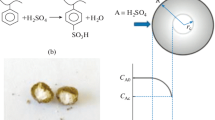Abstract
Styrene is a commonly used co-monomer in vinyl ester (VE) resins, which acts as a reactive diluent and is required in most liquid molding fabrication methods to reduce viscosity and improve overall resin performance. Resins containing low hazardous air pollutant contents have been developed to reduce the styrene emissions during composite fabrication. VE monomers with a bimodal molecular weight distribution have been used to effectively decrease the amount of styrene in the system while maintaining low resin viscosities. Fatty acid vinyl ester (FAVE) resins partially replace styrene with non-volatile fatty acid monomers to reduce styrene emissions. The emissions from bimodal and FAVE resins were measured as a function of time and various parameters, including styrene content, VE molecular weight, and fatty acid monomer content and chain length. The initial emission rate from VE resins is only dependent on styrene content for constant evaporation geometry. Furthermore, the evaporation rate constant was the same regardless of VE molecular weight, styrene content, or the use of co-reactive diluent (MFA monomers). The diffusivity was not dependent on the styrene content in the resin, but decreased linearly as the VE molecular weight increased because of a corresponding increase in the resin viscosity. The diffusivity also increased as the content of MFA increased because of a decrease in the resin viscosity with high MFA content at high emission time. Furthermore, the emission profiles were accurately modeled using a modified version of 1D diffusion through a planar sheet that accounts for the depth change as a function of styrene evaporation. Overall, the model predicted emission profiles similar to the experimentally measured profiles as a function of time for various styrene contents, VE molecular weights, and fatty acid monomer contents.









Similar content being viewed by others
References
Aldrich Chemicals product specifications for Styrene 99% (2004) Aldrich, Milwaukee
ASTM D1980-87 (1987) Annual Book of ASTM Standards. ASTM, West Conshohocken, pp 428
ASTM D1652-90 (1990) Annual Book of ASTM Standards. West Conshohocken, Pa.: ASTM, pp 341
Bassett S (ed) (2003) Emission Control Strategies: A guide for composites manufacturers. Ray Publishing, Inc, Wheat Ridge
British Plastics Federation (1995) Determination of Styrene Evaporation from Unsaturated Polyester Resins; British Standard 2782: Part 4—Method 432D,
Carslaw HS, Jaeger JC (1959) Conduction of Heat in Solids, 2nd edn edn. Oxford University Press, London
Crank J (1975) The mathematics of diffusion, 2nd edn. Oxford University Press, London
Environmental Protection Agency (2003) National emissions standards for hazardous air pollutants: reinforced plastic composites production. Fed Regist 68:19375
Hiss TG, Cussler EL (1973) Diffusion in high viscosity liquids. AIChE J 19:698
Lacovara B (1999) CFA, 1
La Scala JJ, Sands JM, Orlicki JA, Robinette EJ, Palmese GR (2004) Fatty acid-based monomers as styrene replacements for liquid molding resins. Polymer 45:7729
La Scala JJ, Orlicki JA, Winston C, Robinette EJ, Sands JM, Palmese GR (2005a) The use of bimodal blends of vinyl ester monomers to improve resin processing and toughen polymer properties. Polymer 46:2908
La Scala JJ, Jeyarajasingam A, Winston C, Sands JM, Palmese GR (2005b) “Predicting the Viscosity of Low VOC Vinyl Ester Resins,” Army Research Laboratory Technical Report, ARL-TR-3681, December
La Scala JJ, Ulven C, Orlicki JA, Jain R, Palmese GR, Vaidya U, Sands JM (2007) Emission modeling of styrene from vinyl ester resins. Clean Technol Environ Policy 9:265–279
Malik M, Choudhary V, Varma IK (2000) Current status of unsaturated polyester resins. Polymer Rev 40:139
Physical Properties Guide for Epoxy Resins and Related Products (2001a) Resolution Performance Products, Houston
Physical Properties Guide for Epoxy Resins and Related Products (2001b) Resolution Performance Products, Houston. p 3
Product Bulletin for Aerojet Accelerator, AMC-2 (2000) Rancho Cordova, CA: Aerojet Chemicals
Sands JM, Fink BK, McKnight SH, Newton CH, Gillespie JW, Palmese GR (2001) Environmental issues for polymer matrix composites and structural adhesives. Clean Prod Process 2:228
Smeal TW, Brownell GL (1994) US Patent 5,292,841
Ulven C, Sands JM, Vaidya UK (2003) “Emission and Mechanical Evaluations of Vinyl Ester Resin Systems,” Army Research Laboratory Technical Report, ARL-TR-2930, March
Vallone J (2004) “NESHAP Requirements Assessment for Miscellaneous Coatings, Adhesives, Sealers, Etc.,” Final Report to ARL, Sustainable Painting Operations for the Total Army
Ziaee S, Palmese GR (1999) Effects of temperature on cure kinetics and mechanical properties of vinyl-ester resins. J Polym Sci 37:725
Acknowledgments
The authors thank the support for this work provided by Strategic Environmental Research and Development Program (SERDP) project PP-1271 and Environmental Security Technology Certification Program (ESTCP) WP-0617.
Author information
Authors and Affiliations
Corresponding author
Rights and permissions
About this article
Cite this article
La Scala, J.J., Orlicki, J.A., Jain, R. et al. Emission modeling of styrene from vinyl ester resins with low hazardous air pollutant contents. Clean Techn Environ Policy 11, 283–292 (2009). https://doi.org/10.1007/s10098-008-0181-4
Received:
Accepted:
Published:
Issue Date:
DOI: https://doi.org/10.1007/s10098-008-0181-4




